Italian Market Gardens in the City of Ryde
Italian migrants settled in the City of Ryde as early as 1879. Carlo Giuliani was one of these pioneers who purchased 14 acres in Eastwood. The early Italian settlers’ origins were found to be northern Italian or from the Aeolian Islands.
The district was attractive because of the abundance of level, fertile land and the opportunity to own and cultivate it. Many migrants arrived with an agricultural background and cleared scrub to set up and cultivate market gardens across the district.
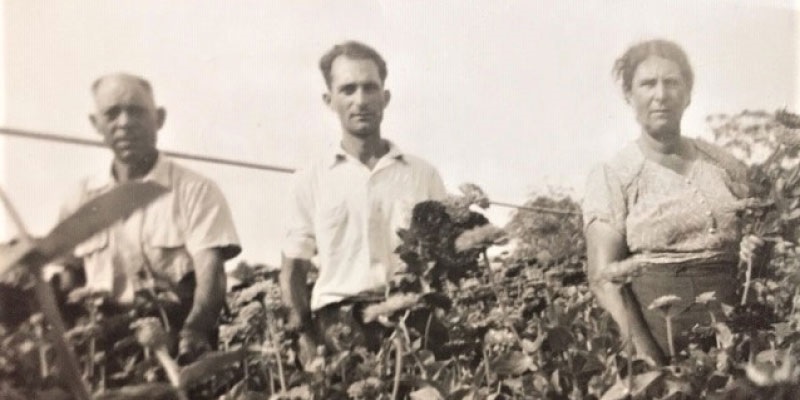
Photo: Domenico and son Frank and wife Maria Conciatore
The farmers lived in modest accommodation described as “sheds” and went on to sponsor family and new arrivals which led to a chain migration to City of Ryde. After World War I, a great majority of Italians in Ryde arrived from poverty-stricken areas of southern Italy, especially Reggio Calabria.
Apart from the language barrier, these migrants had to assimilate in many other ways: a new landscape, soil type, seasons in opposition to those in Europe, new climate, and they had to overcome the wilfulness of nature. Other adversities included plant and poultry diseases, pests, rabbits, mice and flying foxes.
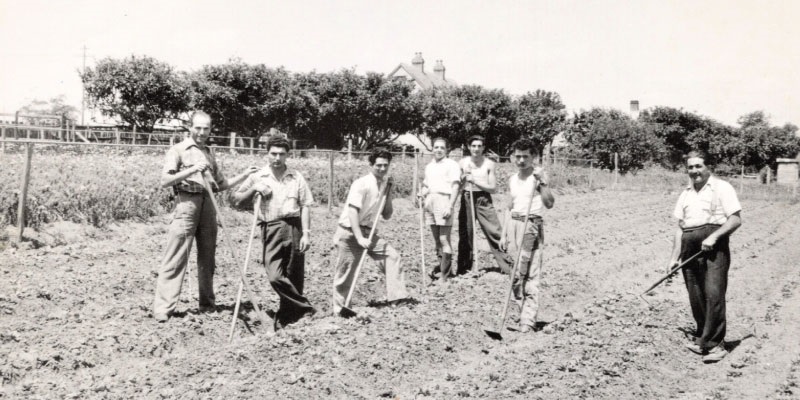
Photo: Nestore Marcellino property on Wicks Road North Ryde. Left to right Giambattista Barillaro, Sam Marcellino, Raffaele Carabetta, Antonio Guidaci, Vince Marcellino, Nicola, Nestore Marcellino. Coxs Road in the background beyond the trees of the Cooney Orchard. Slightly visible is the Cooney house. Now Holy Spirit Church site.
They practised mixed farming, growing seasonal vegetables and flower varieties and introduced new farming methods as well as new plant types. Days were long and work was physically arduous. Where possible, they harnessed the natural water resource of rivers and creeks, while Carmelo Rocca, Domenico Conciatore, Pietro Lombardo and Mark Madafiglio built dams on their properties.
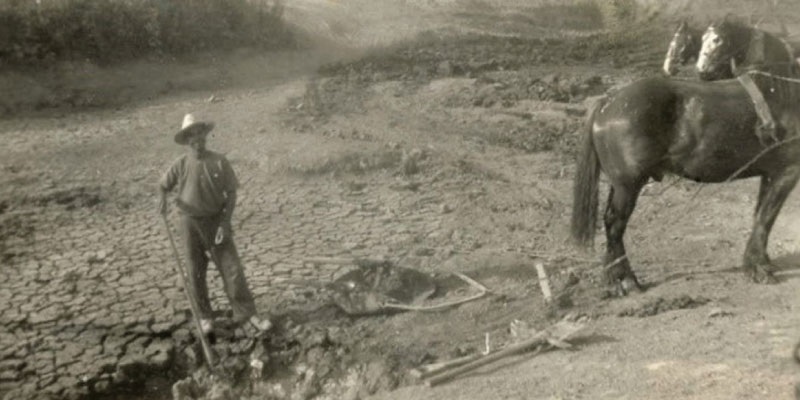
Photo: Carmelo Rocca on Smalls Road farm,digging dam with horse “Nugget” c. 1940. Today this portion of the farm is Santa Rosa Park. Named after Carmelo’s wife Santa and his daughter-in-law Rose Rocca.
Watering was done by hand or, later, using the Skinner watering system: rows of raised water pipes bearing sprinklers for field irrigation.
Fertilising was accomplished by hand and chicken manure from the local poultry farms was a popular source of fertiliser. Planting was performed following the lunar phases, as was practised in Italy. The early farmers used picks and shovels and single-furrow horse-drawn ploughs to work their land. It wasn’t until the 1940s that tractors came into use for ploughing.
Livestock such as cows and goats was kept; often a few chickens for their eggs (although the area was dotted with poultry farms), and a pig or two for the annual salami-making weekend. Older boiler chickens (hens past their egg-laying days) were used in the famous Sunday lunch, slow-cooked ragu sugo.
The migrants planted European, particularly Mediterranean, fruit trees – figs, olives, persimmons, pomegranates, prickly pears, lemons – and Mediterranean vegetables and herbs unfamiliar to the resident Anglo-Australian population – continental parsley, basil, chilli, eggplants, artichokes, Roma tomatoes, rapi and endive. Giuseppe Papandrea on Goulding Road and Giacomo Severino on Agincourt Road grew new potatoes (today’s baby potatoes), all washed by hand and sold under the requirements of the Potato Board. And let us not forget the flowers grown for market – daisies, carnations, stock, sweet williams, dahlias – and, in particular, poppies, a very popular flower.
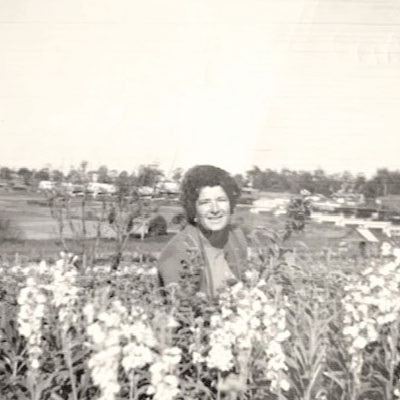
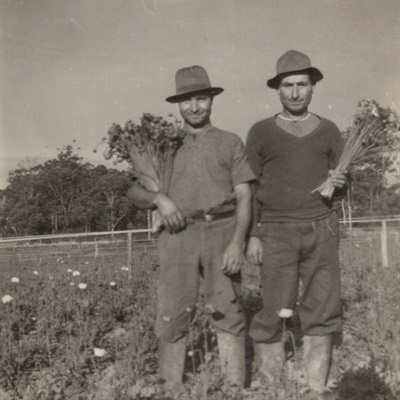
Photos (left): Giovanna Papallo, amongst their stock flowers. Formerly Waterloo Road farm, now Macquarie Sports Centre on Gymnasium Road North Ryde.
Photo (right): Tom and Pasqale Tassone in the flower fields on Lane cove Road farm (c. 1940)
Flax plants were also grown. Their resilient sword-shaped leaves were split and used to tie bunches of flowers together.
An agricultural first for Ryde
Pioneering celery-grower, Calabrian, Giuseppe Mesiti, is believed to have set up the first celery farm in North Ryde, if not New South Wales on his property on Fontenoy Road, harvesting his first crops in the late 1930s. Prior to settling in North Ryde, Giuseppe had worked on farms in South Australia’s celery-growing area where he learnt the method of producing optimum quality celery. He shared this knowledge with fellow farmer Carmelo Rocca who went on to produce quality celery on his farm at Ryde.
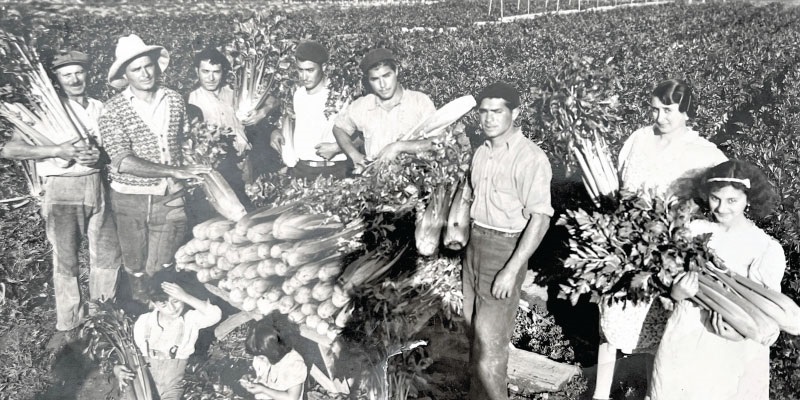
Photo: Fontenoy Road, North Ryde, 1939 - Celery Harvest. Fortunato Mesiti, Giuseppe Mesite (landowner), fortunato Mesiti Jnr, Salvatore Mesiti, Vincenzo Mesiti, Francesco Mesiti and Giovanna Maria Mesiti, daughter Pauline seated are Angelo and Mary Mesiti.
Transmitting knowledge of new techniques and sharing plants, cuttings, seeds and newly propagated plants, as well as advice for growing better crops, was not uncommon in that era. The Italian migrants ran sustainable farms, conserving, recycling, composting, preserving excess produce and sharing their abundance with their community.
Haymarket
In the early days, produce was taken to market by horse and cart and later on, the few farmers who owned trucks, assisted neighbouring farmers with cartage. This involved early morning starts and laborious manual loading and unloading of produce as there were no forklifts.
The role of women
The Italian women were the pillars and the glue of farming life, many of them firstly having to overcome separation from their husbands who had migrated before them, sometimes six or even ten years earlier. Once on the farm, the women set to work. We learn of tomato boxes being used as playpens, placed between crop rows while the child’s mother was hunched over, weeding or watering or pruning, working seven days a week in the heat, rain and frost, and late at night bunching flowers or hand-washing the family laundry. The women cared for their children and taught them to carry out the simpler tasks of collecting eggs, feeding the animals and assisting in the daily home chores. The children were also put to work on the land, before and after school and in the school holidays, picking, bunching, watering. Farming was a family affair.
They carried on their traditions of cooking with seasonal produce, using the few ingredients required in the traditional cucina povera – poor man’s kitchen menu. Many cooked the traditional Sunday slow-cooked ragu sugo, and they all maintained the annual rituals of salami-making weekend and tomato passata-making day, hosting many friends and relatives who joined in. They also ‘fed their farmhands’ hot meals, sometimes serving 20 men or more.
Many women felt isolated in faraway Australia, without the support of their extended families who remained in Italy, and little social support locally. In the end, however, a sense of brotherhood arose in the tight-knit community.
New era for Ryde
All good things come to an end and unfortunately for the thriving market gardens of the North Ryde/Eastwood/Marsfield area, in the early 1960s an area of over 1000 acres was resumed by the State Planning Authority for the Macquarie University campus. Around the same time came the development of the North Ryde (now Macquarie Park) high-tech industrial precinct housing local and international companies. In one example, the Martelli acreage on Vittoria (now Talavera) Road was purchased by international company AstraZeneca. Once a home, a farm and workplace to a migrant family, today home to a multinational. It has been said that every now and then one would see a rhubarb sprout through the manicured lawns of these former market garden locations. The land resumed to build North Ryde High School was owned by Italian market gardeners, the La Rosa and Mulè families, as was Ryde High, resumed from Ferdinando Mesiti, and Ryde Catering College from Mario Mangano.
Subdivision developments from the market gardens saw the construction of townhouses, unit blocks and numerous suburban residences. The Rocca family built a neighbourhood shopping centre on their former market garden on Quarry Road, Ryde, which still operates to this day. The farms in the areas of North Ryde, Ryde, Denistone and Eastwood gave way to residential subdivisions and Housing Commission homes. A precious relic remains on the now grounds of Macquarie University: a hand-built sandstone cottage by Bortolo Ricetti along with seven of his olive trees and a persimmon tree, the only memory of Italian market gardens in the City of Ryde.
Recently an anthology publication titled A One-Way Ticket was released which covers the Italian migration and settlement to the City of Ryde. Curated and compiled by Angelina Bonifacio it is available at Ryde Library.
If you wish to purchase a copy, click here.
Written by Angelina Bonifacio, Curator and Compiler of A One-Way Ticket, Italian Migrants of Ryde publication. This is an extract from A One-Way Ticket, Italian Migrants of Ryde.